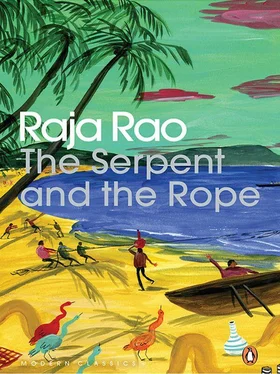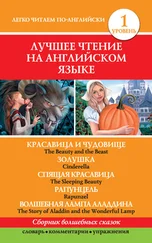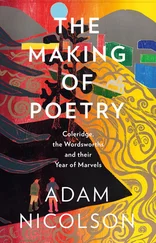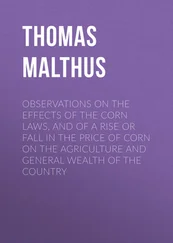Raja Rao - The Serpent and the Rope
Здесь есть возможность читать онлайн «Raja Rao - The Serpent and the Rope» весь текст электронной книги совершенно бесплатно (целиком полную версию без сокращений). В некоторых случаях можно слушать аудио, скачать через торрент в формате fb2 и присутствует краткое содержание. Год выпуска: 2014, Издательство: Penguin Publications, Жанр: Современная проза, на английском языке. Описание произведения, (предисловие) а так же отзывы посетителей доступны на портале библиотеки ЛибКат.
- Название:The Serpent and the Rope
- Автор:
- Издательство:Penguin Publications
- Жанр:
- Год:2014
- ISBN:нет данных
- Рейтинг книги:4 / 5. Голосов: 1
-
Избранное:Добавить в избранное
- Отзывы:
-
Ваша оценка:
- 80
- 1
- 2
- 3
- 4
- 5
The Serpent and the Rope: краткое содержание, описание и аннотация
Предлагаем к чтению аннотацию, описание, краткое содержание или предисловие (зависит от того, что написал сам автор книги «The Serpent and the Rope»). Если вы не нашли необходимую информацию о книге — напишите в комментариях, мы постараемся отыскать её.
The Serpent and the Rope — читать онлайн бесплатно полную книгу (весь текст) целиком
Ниже представлен текст книги, разбитый по страницам. Система сохранения места последней прочитанной страницы, позволяет с удобством читать онлайн бесплатно книгу «The Serpent and the Rope», без необходимости каждый раз заново искать на чём Вы остановились. Поставьте закладку, и сможете в любой момент перейти на страницу, на которой закончили чтение.
Интервал:
Закладка:
I walked Savithri back to Girton College, one evening, feeling we were laughing in a cinema. At the hotel John the Porter gave me a letter. It was from Madeleine. It was a rigmarole of aches and anxieties. But it gave me self-assurance: man needs a woman to stand on his pedary bones. You must have a spot, a centre — to run away from.
People have asked me — Georges among them — what indeed it was that happened between Savithri and me in Cambridge. Nothing more had happened, in fact, than if you see deep and long at silence you perceive an orb of centripetal sound which explains why Parvathi is daughter of Himalay, and Sita born to the furrow of the field. I heard myself say I heard myself. Or I saw my eyes see that I saw. She became the awareness behind my awareness, the leap of my understanding. I lost the world and she became it.
For whatever I gave her she accepted, as the Ganges receives the waters of the Himalayas, that go on down to the sea and come again as white flakes of snow, then blue, then very green; and as, when the sun comes northward again, the ice melts and once more the Ganges takes the waters down to the sea — so we gave love to each other, as though it did not belong to us, but to a principle, an other, an impersonal reality, from which we saw gifts emerge in each of us, and gave each other with ceremony. For us therefore all was celebration, festival…
Truth is the fact of existence. That is, truth is the essence of fact; and as such truth and existence are one and the same. Man sees himself in woman as essence, the fact of womanhood is the meaning of his life. If there were nothing other, you could not know that you are. If Parvathi had not sat and prayed that Shiva would open his eyes, Shiva would never have opened his eyes and there would never have been a world. Love is the honey of knowledge, knowing is sweet because woman is.
A man’s world would have led all of us, one by one, to the top of Himalaya; and like the Cathars, who hated mating and the making of children, we would have taken consolamentum and flung ourselves over the precipice, singing hymns on the Void: ‘No aias merce de la carn, mais aias merce del esperit pausat en carcer.’ Buddhism died in India because it became ascetic, and so denied womanhood its right to exist. Those who hate woman — who debase woman — must end themselves, as the Cathars did, fasting unto death. Mahatma Gandhi respected women as sisters, and not as mates — he too disliked the process of loving and of having children — and so he made them into little men. The world of man is the denial of the earth, it is just like a country with a President and not a king.
All the world is spread for woman to be, and in making us know the world woman shows that the world is oneself seen as the other. Union is proof that the Truth is non-dual. ‘As one embraced by a darling bride,’ says the Brihadaranyaka Upanishad, ‘knows naught of “I” and “Thou”, so self-embraced by the foreknowing (solar) self knows naught of “myself” within or “thyself” without.’ Not one is the Truth, yet not two is the Truth. Savithri proved that I could be I.
One cannot possess the world, one can become it: I could not possess Savithri — I became I. Hence the famous saying of Yagnyavalkya to his wife, ‘The husband does not love the wife for the wife’s sake, the husband loves the wife for the sake of the Self in her.’
Thus the king is masculine to his kingdom, and feminine in relation to the Absolute, the Truth.
That ugly revolutionary word ‘Capitalist’ took on a new significance for me: clearly it was born of the man-proud nineteenth century, century of inventions, empires. Man, the hero of man: Clive more proud to be the obedient servant of Company Directors than of some Azalais des Baux. And after the death of the Prince Consort how much more Queen Victoria incarnated in him than as herself. Victorianism was born of her widowhood — in the contemplation of him. Gladstone and Disraeli were her alternative symbols. She the sovran of the empire, to whom Gordon of Khartoum knelt as to a liege. How different the lovers of Queen Elizabeth I, and the world of Marlowe, Shakespeare, and the Armada! The ascetic world of Queen Victoria disintegrated into many man-kingdoms, and the last was the one created by Mahatma Gandhi. Victorianism died not in London or Melbourne but in New Delhi, cremated there by a distinguished representative of the Germano-British Royal Family. Godse, who killed Mahatma Gandhi, was like Saint Dominic. But the inquisition was born to justify life not to kill life.
Strange, it seemed to me, on those days walking by the Cam, singing Sankara’s hymns to myself, waiting for some bus or car that would deposit Savithri by my side, how my thoughts took corporeality, how I understood the rhythm and meaning of history through her. My thoughts turned to Christianity. How curious that it starts — even in the catechism — with Eve and the Fall, and that Hinduism, too, glorifies the Mother. How beautiful are those hymns to the Mother, of Sankara:
Annapurné Sadapurné
Sankara prānavallabhé
She, ever full and plenteous,
Sankara’s divine lady.
But alas decadent Hinduism led pure Vedanta to end in the concretization of womanhood — the Tantriks.
I suddenly remembered Father saying that one of my ancestors in the sixteenth century or thereabouts was a great Tantrik, who had written some textbook on the yogachakras. The story goes how he brought a virgin to the house, for adoration and worship, and when he had sat hour after hour in mantra and meditation, milk was brought and honey, camphor and kadamba flowers. Then the young lady — someone of the concubine class, called Radha — was made to stand naked, and sixteen men came in, who had all fasted for eleven days and prayed for eleven nights, white as muslin in their skin, bright- eyed as the sacrificial fire that burnt in front of them, with ashes on their foreheads, and with filigree at their waists and ankles. They poured the honey first, then the milk and the flowers, on the young head and breast and limbs of the girl, and how it flowed over her womanhood, as though the world was made of the true substance of woman, just as honey is made of the true stuff of flower. And the girl herself stepped forward, singing:
I have no body, I have no mind,
I am the essence of creation;
Myself uncreate,
The world my dwelling place;
My Lord, is he who dwells in Kailas,
Lord of the Trident,
He with the moon in his hair;
My spouse, the origin of Sound.
Now she stepped towards the fire, went round and round it, seven noble times, smeared her body with ashes, and borrowing a cloth from one of the Brahmins walked out an ascetic, a nun fulfilled. The woman needs our worship for her fulfilment, for in worshipping her we know the world and annihilate it, absorbing it into ourself. We should be Shiva that woman be dissolved — and with her the world. For the world is meant not for denial but for dissolution.
The object, I said to myself, is woman. Hence the concupiscence of ascetics for their loin-cloth, their kamandala, their stick, or naked feet. And Georges, eating marmalade or chestnut jam, how he sucked it, rolled it over and over his tongue, then swallowed it, little by little, making glougloutinating sounds, and looking innocently at Madeleine. And the Abbé de Grefonville, when he came to visit us, rubbed his snuff as though it gave him a self-exciting sensation, a release of himself. When it went up his nose he closed his eyes, surely not in fear of burning his eyes, but because it was such joy to feel himself in. No sinner, no Don Juan can have come back to the world as ghost, but most cenobites must have. No wonder then that mostly women are possessed by ghosts and not men. Ghosts prefer — in India at least — girls of sixteen or widows.
Читать дальшеИнтервал:
Закладка:
Похожие книги на «The Serpent and the Rope»
Представляем Вашему вниманию похожие книги на «The Serpent and the Rope» списком для выбора. Мы отобрали схожую по названию и смыслу литературу в надежде предоставить читателям больше вариантов отыскать новые, интересные, ещё непрочитанные произведения.
Обсуждение, отзывы о книге «The Serpent and the Rope» и просто собственные мнения читателей. Оставьте ваши комментарии, напишите, что Вы думаете о произведении, его смысле или главных героях. Укажите что конкретно понравилось, а что нет, и почему Вы так считаете.












